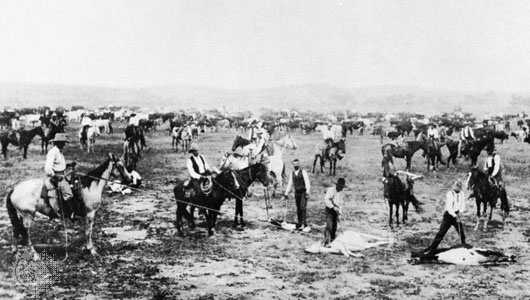cowboy
 in the western United States, a horseman skilled at handling cattle, an indispensable labourer in the cattle industry of the trans-Mississippi west, and a romantic figure in American folklore. Pioneers from the United States encountered the vaquero (Spanish, literally “cowboy”; English “buckaroo”), on ranches in Texas about 1820, and some pioneers mastered his skills—the use of lariat, saddle, spurs, and branding iron. But cattle were only a small part of the economy of Texas until after the Civil War. The development of a profitable market for beef in northern cities after 1865 prompted many Texans to go into cattle raising. Within a decade that lucrative industry had spread across the Great Plains from Texas to Canada and westward to the Rocky Mountains.
in the western United States, a horseman skilled at handling cattle, an indispensable labourer in the cattle industry of the trans-Mississippi west, and a romantic figure in American folklore. Pioneers from the United States encountered the vaquero (Spanish, literally “cowboy”; English “buckaroo”), on ranches in Texas about 1820, and some pioneers mastered his skills—the use of lariat, saddle, spurs, and branding iron. But cattle were only a small part of the economy of Texas until after the Civil War. The development of a profitable market for beef in northern cities after 1865 prompted many Texans to go into cattle raising. Within a decade that lucrative industry had spread across the Great Plains from Texas to Canada and westward to the Rocky Mountains.Cattle could be managed most efficiently in herds of about 2,500 head, with 8 to 12 cowboys for each herd. In the autumn the cowboys rounded up the cattle, including ownerless ones from the open range, and branded those not already branded; in the winter they kept watch over the herd; and in the spring they selected the cattle ready for market and drove them to the nearest railroad town, often hundreds of miles away. There the cattle were sold to eastern buyers and the cowboys enjoyed a brief period of relaxation before returning home to begin the routine of another year.
As the agricultural frontier moved west, the open range was transformed into farms, and by 1890 the cattlemen had been forced to settle on ranches with barbed-wire boundaries and usually close to a railroad. The legendary era of the cowboy was over, but in dime novels and other fiction of the late 19th and 20th centuries he attained immortality as the taciturn, self-reliant, and masterful hero of the West. Motion pictures and television have perpetuated that image.
- Landa, Diego de
- Landau
- landau
- Landau, Ezekiel
- Landau, Lev Davidovich
- land bridge
- land crab
- Land, Edwin Herbert
- Landen, John
- Lander
- Lander, Harald
- Lander, Richard Lemon
- Landes
- Land forces of the belligerents, Aug. 4, 1914
- landform
- land-grant college
- landgrave
- landing craft
- landing ship, tank
- Landini, Francesco
- Landis, Kenesaw Mountain
- Land League
- landlord and tenant
- land mine
- Landnámabók